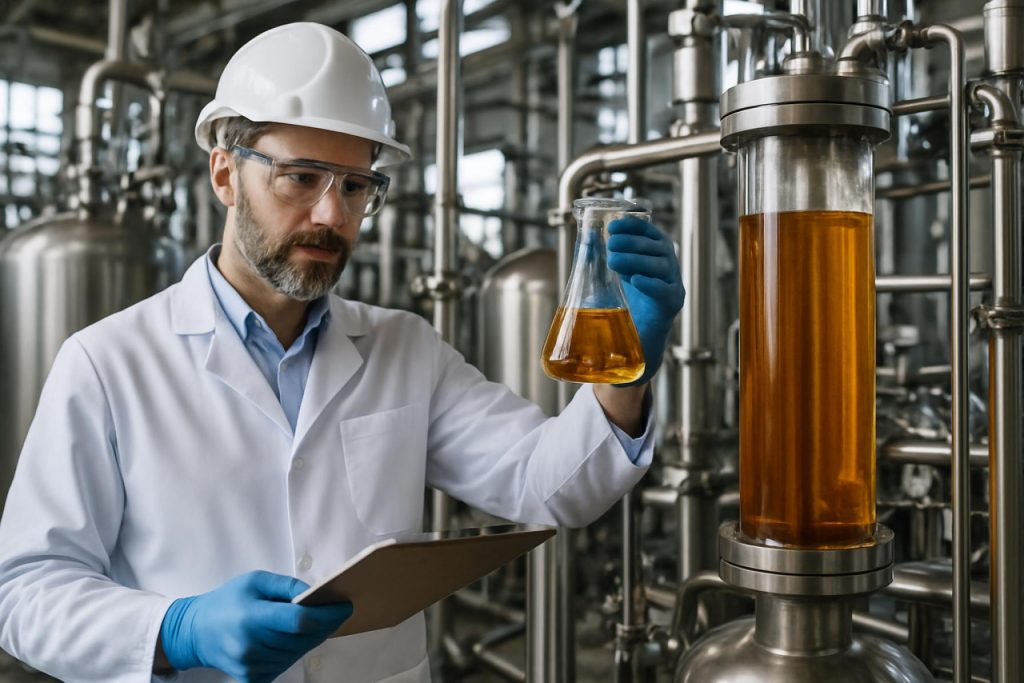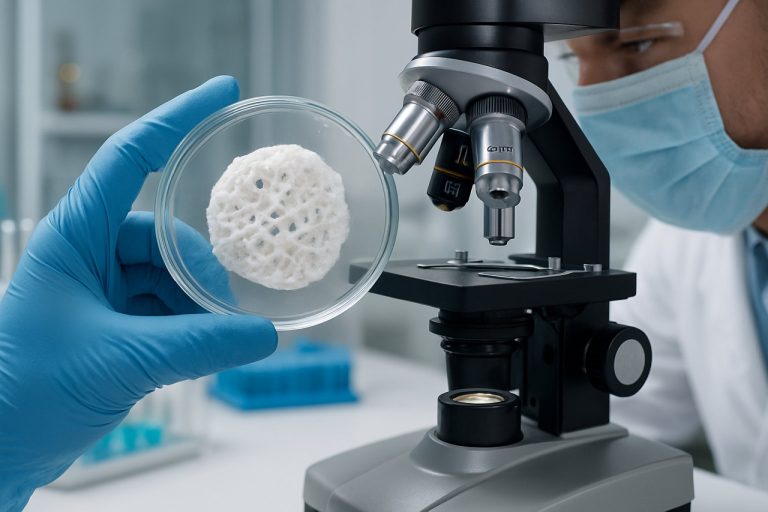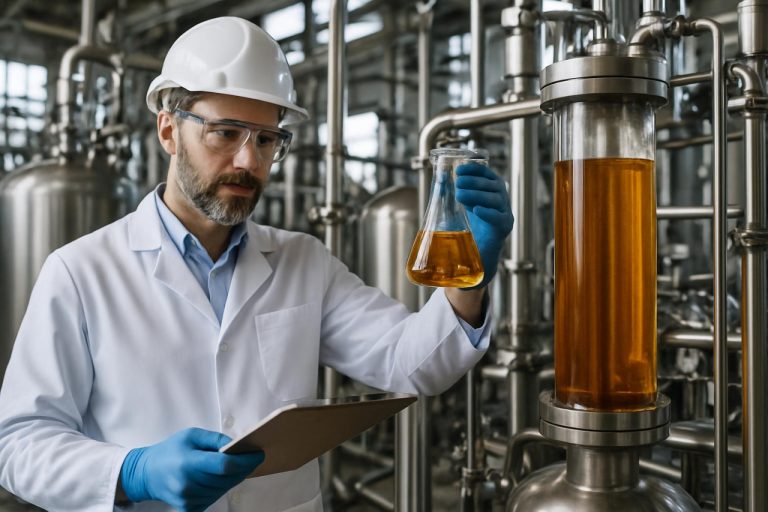
Xylooligosaccharide Production Technology in 2025: Innovations, Market Dynamics, and the Road to Sustainable Growth. Discover How Cutting-Edge Processes Are Shaping the Future of Prebiotic Ingredients.
- Executive Summary: Key Trends and Market Drivers
- Global Market Forecasts Through 2030
- Emerging Production Technologies and Process Innovations
- Raw Material Sourcing and Supply Chain Developments
- Regulatory Landscape and Quality Standards
- Competitive Analysis: Leading Companies and New Entrants
- Applications in Food, Feed, and Pharmaceuticals
- Sustainability and Environmental Impact
- Investment, Partnerships, and M&A Activity
- Future Outlook: Opportunities and Challenges Ahead
- Sources & References
Executive Summary: Key Trends and Market Drivers
Xylooligosaccharide (XOS) production technology is experiencing significant advancements in 2025, driven by rising demand for prebiotic ingredients in food, beverage, and nutraceutical sectors. XOS, derived primarily from lignocellulosic biomass such as corn cobs, sugarcane bagasse, and hardwoods, is valued for its health benefits, including gut microbiota modulation and improved digestive health. The global focus on sustainable and functional food ingredients is accelerating investments in efficient, scalable, and eco-friendly XOS production methods.
Key trends shaping the sector include the transition from traditional acid hydrolysis to advanced enzymatic and integrated bioprocessing techniques. Enzymatic hydrolysis, utilizing xylanase enzymes, is gaining traction due to its higher selectivity, milder reaction conditions, and reduced by-product formation. Companies such as DuPont (now part of IFF) and Novozymes are at the forefront, supplying specialized enzymes and collaborating with manufacturers to optimize yields and lower production costs. Additionally, the adoption of membrane filtration and chromatographic purification is enhancing product purity and process efficiency.
In 2025, China remains the largest producer and exporter of XOS, with major players like Shandong Longlive Bio-Technology and Henan Xylo Biotechnology expanding capacity to meet both domestic and international demand. These companies are investing in process automation and energy-efficient technologies to improve sustainability and comply with tightening environmental regulations. Meanwhile, European and North American manufacturers are increasingly entering the market, leveraging local agricultural residues and focusing on non-GMO, clean-label production to cater to health-conscious consumers.
Strategic partnerships between enzyme producers, biomass suppliers, and food ingredient companies are accelerating technology transfer and commercialization. For example, collaborations between enzyme innovators like Novozymes and food ingredient leaders are facilitating the integration of XOS into mainstream food products, including dairy, bakery, and beverages. Regulatory approvals in key markets, such as the European Union and the United States, are further supporting market expansion and encouraging investment in new production facilities.
Looking ahead, the outlook for XOS production technology is robust. Continued R&D is expected to yield more cost-effective and sustainable processes, including the valorization of agricultural waste streams and the development of novel enzyme cocktails. As consumer awareness of gut health grows and food manufacturers seek innovative prebiotic solutions, the XOS sector is poised for steady growth, with technology innovation and supply chain integration as primary market drivers.
Global Market Forecasts Through 2030
The global market for xylooligosaccharide (XOS) production technology is poised for significant growth through 2030, driven by increasing demand for prebiotic ingredients in food, beverage, and nutraceutical sectors. As of 2025, the industry is witnessing a transition from pilot-scale to commercial-scale production, with several key players expanding their manufacturing capacities and investing in advanced extraction and purification technologies.
Major producers such as Shandong Longlive Bio-Technology Co., Ltd. and Yakult Honsha Co., Ltd. are at the forefront of this expansion. Shandong Longlive Bio-Technology Co., Ltd., one of the world’s largest XOS manufacturers, continues to scale up its enzymatic hydrolysis processes, focusing on improving yield and purity while reducing production costs. The company’s ongoing investments in biorefinery infrastructure and process optimization are expected to further solidify its leadership in the global XOS market.
In parallel, Yakult Honsha Co., Ltd.—renowned for its probiotic beverages—has integrated XOS into its product development pipeline, leveraging proprietary fermentation and enzymatic conversion technologies. The company’s research and development efforts are aimed at enhancing the functional properties of XOS, such as its prebiotic efficacy and stability in various food matrices, which is anticipated to drive broader adoption in the Asia-Pacific region and beyond.
Technological advancements are also being observed in the enzymatic production of XOS from lignocellulosic biomass, with companies like Novozymes A/S supplying specialized enzyme solutions to optimize the hydrolysis of xylan-rich agricultural residues. These innovations are expected to lower raw material costs and improve the sustainability profile of XOS production, aligning with global trends toward circular bioeconomy and waste valorization.
Looking ahead to 2030, the XOS production technology market is projected to benefit from regulatory approvals for novel food ingredients in North America and Europe, as well as increasing consumer awareness of gut health. Strategic collaborations between ingredient manufacturers, food companies, and biotechnology firms are likely to accelerate the commercialization of next-generation XOS products with tailored functionalities. As a result, the sector is expected to experience robust compound annual growth rates, with Asia-Pacific maintaining its dominance while North America and Europe emerge as high-potential markets for technological adoption and product innovation.
Emerging Production Technologies and Process Innovations
Xylooligosaccharide (XOS) production technology is undergoing rapid transformation in 2025, driven by the demand for prebiotic ingredients in food, beverage, and nutraceutical sectors. Traditionally, XOS is produced via hydrolysis of xylan-rich lignocellulosic biomass using acid, alkali, or enzymatic methods. However, recent years have seen a shift toward more sustainable, efficient, and scalable processes.
A major trend is the adoption of advanced enzymatic hydrolysis, which offers higher selectivity and milder reaction conditions compared to chemical methods. Leading enzyme manufacturers such as Novozymes and DSM are actively developing tailored xylanase enzymes to optimize XOS yield and purity. These innovations are enabling the use of diverse feedstocks, including agricultural residues like corn cobs, wheat straw, and sugarcane bagasse, thus supporting circular bioeconomy initiatives.
Process intensification is another area of innovation. Companies are integrating membrane filtration and chromatographic purification to enhance product recovery and reduce energy consumption. For example, GEA Group supplies membrane and separation technologies that are increasingly being adopted in XOS production plants for efficient downstream processing. This integration is crucial for meeting the stringent purity requirements of food-grade XOS.
Continuous processing and biorefinery concepts are also gaining traction. In 2025, several pilot and commercial-scale facilities are exploring the co-production of XOS alongside other value-added products such as bioethanol and organic acids. This approach is exemplified by companies like DuPont, which is leveraging its expertise in bioprocessing to develop integrated platforms for lignocellulosic biomass valorization.
Automation and digitalization are further enhancing process control and traceability. Equipment suppliers such as Bühler Group are offering digital solutions for real-time monitoring and optimization of XOS production lines, supporting consistent product quality and regulatory compliance.
Looking ahead, the outlook for XOS production technology is marked by continued investment in enzyme engineering, process integration, and sustainable feedstock utilization. The sector is expected to benefit from collaborations between biotechnology firms, equipment manufacturers, and food ingredient companies, accelerating the commercialization of next-generation XOS products with improved functional properties and environmental profiles.
Raw Material Sourcing and Supply Chain Developments
Raw material sourcing and supply chain management are critical factors shaping the xylooligosaccharide (XOS) production landscape in 2025 and the near future. XOS is primarily derived from lignocellulosic biomass, with agricultural residues such as corn cobs, wheat straw, sugarcane bagasse, and hardwoods serving as the main feedstocks. The availability, cost, and sustainability of these raw materials directly influence the scalability and economics of XOS production.
In 2025, the industry is witnessing a shift toward more sustainable and regionally optimized sourcing strategies. Leading XOS producers are increasingly forming partnerships with agricultural cooperatives and forestry operations to secure consistent supplies of high-xylan-content biomass. For example, Shandong Longlive Bio-technology Co., Ltd., one of the world’s largest XOS manufacturers, sources corn cobs from local farmers in Shandong province, leveraging proximity to reduce transportation costs and carbon footprint. This model is being emulated in other regions, with companies seeking to localize supply chains and minimize environmental impact.
Supply chain resilience has become a focal point following recent global disruptions. Producers are diversifying their raw material base to mitigate risks associated with crop failures, price volatility, and logistical bottlenecks. Some manufacturers, such as Yakult Honsha Co., Ltd., are exploring alternative feedstocks, including hardwood chips and sugarcane bagasse, to ensure year-round production and to align with circular economy principles by valorizing agricultural byproducts.
Technological advancements in biomass pretreatment and fractionation are also influencing raw material strategies. The adoption of advanced hydrothermal, enzymatic, and acid hydrolysis processes allows for the efficient extraction of xylan from a broader range of feedstocks, including previously underutilized residues. This flexibility is expected to expand the geographic footprint of XOS production, particularly in regions with abundant lignocellulosic resources.
Looking ahead, the outlook for raw material sourcing in XOS production is shaped by both regulatory and market trends. Sustainability certifications and traceability are becoming increasingly important, with major buyers and end-users demanding proof of responsible sourcing. Companies like DuPont (now part of IFF) are investing in digital supply chain platforms to enhance transparency and compliance with evolving environmental standards.
In summary, 2025 marks a period of strategic adaptation in XOS raw material sourcing, characterized by local partnerships, feedstock diversification, and technological innovation. These developments are expected to strengthen supply chain resilience and support the continued growth of the XOS sector in the coming years.
Regulatory Landscape and Quality Standards
The regulatory landscape for xylooligosaccharide (XOS) production technology is evolving rapidly as global demand for prebiotic ingredients intensifies. In 2025, XOS is increasingly recognized as a novel food ingredient, prompting regulatory agencies to refine safety, labeling, and quality standards. The European Union, through the European Food Safety Authority (EFSA), has established a framework for the assessment of novel foods, including XOS, focusing on safety, purity, and functional claims. XOS products must comply with the EU’s Novel Food Regulation (EU) 2015/2283, which requires comprehensive dossiers demonstrating safety and efficacy before market entry. Similar regulatory scrutiny is observed in North America, where the U.S. Food and Drug Administration (FDA) evaluates XOS under the Generally Recognized as Safe (GRAS) notification process, emphasizing manufacturing controls and contaminant limits.
In Asia, China remains a dominant producer and consumer of XOS, with the National Health Commission (NHC) and State Administration for Market Regulation (SAMR) overseeing food additive approvals and quality standards. Chinese standards, such as GB 29924-2013 for food additives, set specific purity and labeling requirements for XOS, reflecting the country’s leadership in both production and regulatory development. Japan, another key market, regulates XOS under the Food for Specified Health Uses (FOSHU) system, which mandates clinical substantiation of health claims and rigorous quality control.
Leading XOS manufacturers are actively aligning with these regulatory frameworks. Shandong Longlive Bio-Technology Co., Ltd., one of the world’s largest XOS producers, has achieved multiple international certifications, including ISO 22000 and HACCP, to ensure compliance with global food safety standards. Yakult Honsha Co., Ltd., a pioneer in functional foods, incorporates XOS in its product lines and adheres to Japan’s FOSHU requirements, setting benchmarks for quality and traceability. DuPont (now part of IFF) and Cargill are also investing in XOS production, leveraging advanced enzymatic hydrolysis technologies and robust quality management systems to meet international standards.
Looking ahead, the next few years will likely see further harmonization of XOS quality standards, driven by international trade and consumer demand for transparency. Industry bodies such as the International Feed Industry Federation and FoodDrinkEurope are expected to play a greater role in shaping guidelines for purity, labeling, and permissible health claims. As regulatory clarity improves, manufacturers will need to invest in traceability, analytical testing, and documentation to maintain market access and consumer trust in the expanding XOS sector.
Competitive Analysis: Leading Companies and New Entrants
The global landscape for xylooligosaccharide (XOS) production technology in 2025 is marked by a dynamic interplay between established industry leaders and innovative new entrants. As demand for prebiotic ingredients continues to rise, particularly in functional foods, beverages, and nutraceuticals, companies are investing in advanced production methods and expanding their manufacturing capacities.
Among the established leaders, Shandong Longlive Bio-Technology Co., Ltd. stands out as one of the world’s largest XOS producers. The company leverages proprietary enzymatic hydrolysis processes and has made significant investments in scaling up production to meet both domestic and international demand. Their XOS products are widely used in food, beverage, and health supplement applications, and the company is recognized for its focus on high-purity, food-grade XOS.
Another major player is Yakult Honsha Co., Ltd., a pioneer in the prebiotic and probiotic sector. Yakult has integrated XOS into its product development pipeline, utilizing its expertise in fermentation and microbial technology to enhance the functional properties of its offerings. The company’s research-driven approach and global distribution network position it as a key influencer in the XOS market.
In Europe, DSM has shown interest in the prebiotic space, including XOS, through its nutrition and health innovation platforms. While DSM’s primary focus has been on other oligosaccharides, its R&D capabilities and partnerships with food manufacturers suggest potential for further expansion into XOS production and application in the near future.
New entrants are also shaping the competitive landscape. Companies such as Quantum Hi-Tech (China) Biological Co., Ltd. have rapidly scaled their XOS production, emphasizing eco-friendly processes and cost-effective enzymatic technologies. Quantum Hi-Tech is notable for its vertical integration, controlling both raw material sourcing and downstream processing, which allows for greater quality control and supply chain resilience.
Looking ahead, the competitive environment is expected to intensify as more biotechnology firms and ingredient suppliers enter the market, attracted by the growing consumer awareness of gut health and the regulatory acceptance of XOS as a novel food ingredient in multiple regions. Strategic collaborations, technology licensing, and investments in continuous processing and biorefinery approaches are likely to define the next phase of industry development. Companies with robust R&D pipelines, scalable production technologies, and strong regulatory compliance will be best positioned to capture market share in the evolving XOS sector.
Applications in Food, Feed, and Pharmaceuticals
Xylooligosaccharides (XOS) are increasingly recognized for their prebiotic properties, driving their integration into food, feed, and pharmaceutical applications. The production technology for XOS has evolved rapidly, with a focus on efficiency, scalability, and sustainability to meet growing demand in 2025 and beyond.
The primary production methods for XOS involve enzymatic hydrolysis and autohydrolysis of lignocellulosic biomass, such as corncobs, sugarcane bagasse, and hardwoods. Enzymatic hydrolysis, using xylanase enzymes, is favored for its specificity and ability to yield high-purity XOS with minimal byproducts. Leading enzyme manufacturers, such as Novozymes and DSM, have developed tailored xylanase formulations to optimize XOS yields and reduce processing costs. These companies are actively collaborating with food and feed producers to integrate XOS production into existing biorefinery operations.
Autohydrolysis, which uses high-temperature water without added chemicals, is also gaining traction due to its lower environmental impact and compatibility with large-scale operations. Companies like Sunresin have commercialized continuous autohydrolysis reactors and advanced resin-based purification systems, enabling the production of food-grade XOS at industrial scale. In 2025, Sunresin’s technology is being adopted by several Asian and European food ingredient manufacturers, reflecting the global expansion of XOS supply chains.
Downstream purification remains a critical step, as food and pharmaceutical applications require high-purity XOS with defined degrees of polymerization. Membrane filtration, ion-exchange chromatography, and resin adsorption are commonly employed. Sunresin and Novozymes are both investing in integrated process solutions that combine hydrolysis and purification, aiming to reduce energy consumption and improve product consistency.
Looking ahead, the XOS production sector is expected to benefit from advances in enzyme engineering, process intensification, and the valorization of agricultural residues. The integration of XOS production into biorefineries—where multiple value-added products are derived from biomass—will further enhance economic and environmental sustainability. As regulatory approvals for XOS as a novel food ingredient expand in North America and Europe, demand is projected to rise, prompting further investment in production capacity and technology innovation by established players and new entrants alike.
Sustainability and Environmental Impact
Xylooligosaccharide (XOS) production technology is increasingly recognized for its potential to contribute to sustainability and reduce environmental impact, especially as the global demand for prebiotics and functional food ingredients rises. In 2025, the sector is witnessing a shift toward greener, more resource-efficient processes, with a focus on valorizing agricultural residues and minimizing waste.
A key sustainability advantage of XOS production lies in its reliance on lignocellulosic biomass—such as corn cobs, wheat straw, and sugarcane bagasse—which are abundant agricultural byproducts. By converting these residues into high-value XOS, manufacturers not only reduce landfill waste but also create new revenue streams for farmers and processors. Leading companies, including Shandong Longlive Bio-Technology and Yakult Honsha, have established large-scale XOS production facilities that utilize enzymatic hydrolysis, a process that operates under milder conditions and generates fewer emissions compared to traditional acid hydrolysis.
Recent years have seen a marked increase in the adoption of enzymatic and membrane-based separation technologies, which further enhance the environmental profile of XOS manufacturing. These methods reduce the need for harsh chemicals and lower energy consumption, aligning with global trends toward decarbonization and circular bioeconomy principles. For example, Shandong Longlive Bio-Technology reports that its proprietary enzymatic process achieves high yields with minimal byproduct formation, supporting both economic and ecological goals.
Water management and effluent treatment are also critical considerations. Companies are investing in closed-loop water systems and advanced filtration to minimize freshwater use and prevent contamination. Yakult Honsha, a major player in the functional food sector, has publicly committed to reducing its environmental footprint across all operations, including XOS production, by implementing energy-saving measures and optimizing resource use.
Looking ahead, the outlook for XOS production technology is closely tied to advances in bioprocess engineering and the broader push for sustainable food systems. Industry bodies and manufacturers are expected to intensify collaboration on best practices, life cycle assessment, and certification schemes to ensure that XOS remains a model of green innovation. As regulatory frameworks tighten and consumer demand for eco-friendly ingredients grows, the sector is poised to further reduce its environmental impact while supporting the transition to a more sustainable bio-based economy.
Investment, Partnerships, and M&A Activity
The landscape of investment, partnerships, and mergers & acquisitions (M&A) in xylooligosaccharide (XOS) production technology is evolving rapidly as demand for prebiotic ingredients intensifies globally. In 2025, the sector is witnessing heightened interest from both established ingredient manufacturers and emerging biotechnology firms, driven by the expanding functional food and nutraceutical markets.
Major ingredient producers are actively investing in XOS production capacity and technology. DuPont Nutrition & Health (now part of IFF) has continued to expand its prebiotic portfolio, with XOS as a strategic focus, leveraging its expertise in enzymatic hydrolysis and bioprocessing. Similarly, Yakult Honsha Co., Ltd., a pioneer in probiotics and prebiotics, has maintained R&D investments in XOS, aiming to integrate these oligosaccharides into new product lines and functional beverages.
In Asia, where XOS production is most advanced, Chinese companies such as Shandong Longlive Bio-Technology Co., Ltd. and Henan Xylo Biotechnology Co., Ltd. have attracted both domestic and international investment to scale up manufacturing and improve process efficiency. These firms are recognized for their large-scale, cost-effective XOS production using agricultural byproducts like corncobs and sugarcane bagasse. Strategic partnerships with food and beverage multinationals have been reported, aiming to secure reliable XOS supply chains and co-develop new applications.
M&A activity is also shaping the sector. In recent years, several mid-sized biotechnology companies specializing in novel enzymatic processes for XOS extraction have become acquisition targets for larger ingredient suppliers seeking to enhance their technological capabilities. For example, Cargill has signaled interest in expanding its prebiotic ingredient offerings, and industry observers anticipate further acquisitions or joint ventures in 2025 and beyond as the company seeks to strengthen its position in the XOS market.
Looking ahead, the next few years are expected to see continued consolidation, with global ingredient leaders seeking to secure proprietary XOS technologies and regional production bases. Partnerships between technology developers and agricultural processors are likely to intensify, particularly as sustainability and upcycling of agricultural residues become central to investment decisions. The sector’s outlook remains robust, with XOS production technology positioned as a key area for strategic investment and collaboration among food, biotech, and agribusiness leaders.
Future Outlook: Opportunities and Challenges Ahead
The future of xylooligosaccharide (XOS) production technology is poised for significant evolution as the global demand for prebiotic ingredients continues to rise in 2025 and beyond. XOS, derived primarily from lignocellulosic biomass such as corncobs, sugarcane bagasse, and hardwoods, is increasingly recognized for its health benefits and functional food applications. The industry is witnessing a shift from traditional acid hydrolysis methods to more sustainable and efficient enzymatic and biotechnological processes, driven by both regulatory pressures and consumer demand for clean-label ingredients.
Key players in the sector, such as Shandong Longlive Bio-Technology Co., Ltd.—one of the world’s largest XOS manufacturers—are investing in advanced enzymatic hydrolysis technologies to improve yield, purity, and cost-effectiveness. These innovations are expected to reduce environmental impact and energy consumption, aligning with global sustainability goals. Similarly, Yakult Honsha Co., Ltd. and QHT (Qingdao) are expanding their production capacities and refining their processes to meet the growing demand from the food, beverage, and nutraceutical sectors.
A major opportunity lies in the valorization of agricultural residues, which not only provides a low-cost feedstock but also supports circular economy initiatives. Companies are exploring integrated biorefinery models, where XOS production is coupled with the generation of other value-added products, such as bioethanol or bioplastics. This approach is being actively pursued by several Asian and European manufacturers, aiming to maximize resource efficiency and profitability.
However, challenges remain. The variability in raw material composition, the need for robust and scalable enzyme systems, and the removal of by-products such as furfural and acetic acid are technical hurdles that require ongoing research and development. Regulatory harmonization across regions, particularly regarding novel food approvals and labeling, will also influence market expansion. For instance, while XOS is approved as a food ingredient in China and Japan, its status in North America and the European Union is still evolving, impacting global trade dynamics.
Looking ahead, the XOS sector is expected to benefit from advances in synthetic biology, enzyme engineering, and process intensification. Collaborations between technology providers, ingredient manufacturers, and end-users will be crucial in overcoming current bottlenecks. As consumer awareness of gut health and functional foods grows, the outlook for XOS production technology remains robust, with significant opportunities for innovation and market growth in the coming years.
Sources & References
- DuPont
- Yakult Honsha Co., Ltd.
- DSM
- GEA Group
- DuPont
- Bühler Group
- International Feed Industry Federation
- FoodDrinkEurope
- Sunresin



